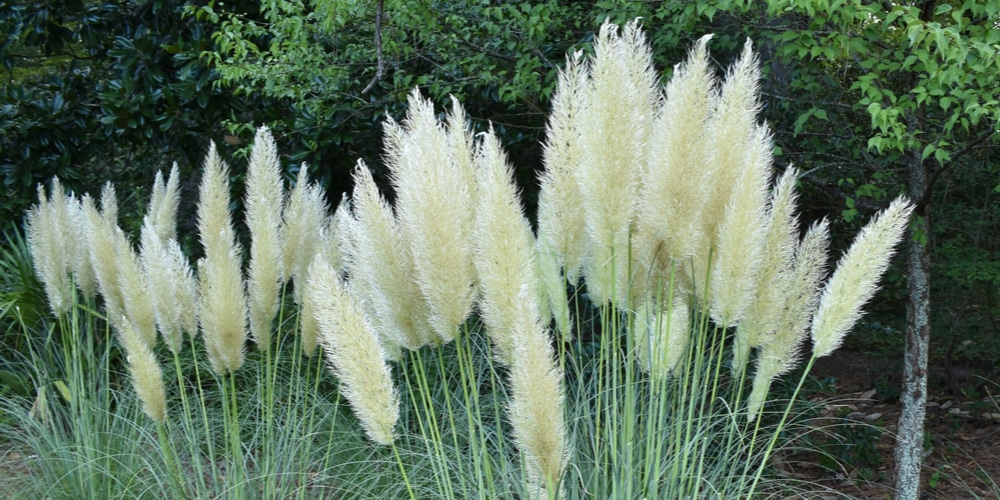Considered to be one of the most beautiful grasses you can find, pampas grass (Cortaderia selloana) is often used as an ornamental plant in gardens. But this perennial can grow quite large, up to 10 feet tall, and may need to be cut back annually to keep it from taking over the garden.
This plant, native to Chile, Brazil, and Argentina, can be aggressive, and if you don’t cut it back, it will produce lots of seeds that can take over your garden or lawn. Despite their stunning plumes of flowers, pampas grasses are actually considered invasive in many areas.
Cutting Pampas Grass Back the Right Way
Regularly pruning pampas grass will help to reduce its size and prevent it from taking over your garden. It should be an annual task that’s done in late winter or early spring. Remember to do this before the plant begins to produce new growth.
While doing this isn’t exactly rocket science, there are a few things you need to keep in mind to ensure you’re pruning it correctly.
Only Use Sharp Shears
Clean cuts will help the plant heal quickly and prevent disease. A blunt or dull blade will crush the stems, damaging the plant. A clean cut also prevents the plant from producing excess growth in an attempt to heal the damaged area.
Be Careful Not to Cut Too Much
If you cut too much of the plant, it will produce more shoots in an attempt to compensate for the lost foliage. This can make the problem worse and cause the plant to become even larger. So, be sure to only remove a third of the foliage at a time. If you need to cut to the ground, do it in stages over the course of a few years.
Avoid Cutting Flowering Stems
Pampas grass produces flowers on stems that can be up to six feet tall. These are the parts of the plant that you want to keep, as they add height and interest to the garden. If you must cut them back, do so carefully and avoid taking off more than a third of the stem.
After you’ve cut back the foliage, you can remove the dead leaves and stems from the plant by hand or with a rake. Be sure to dispose of them properly, so they don’t take root and begin growing again.
Cut at the Right Angle
It’s not necessarily wrong to cut pampas grass in a straight line. However, cutting at an angle will help the plant to produce new growth that’s more compact and fuller. This will give your plant a neater appearance and prevent it from becoming too large.
A 45-degree angle is ideal, but you can also cut the plant at a 30-degree or 60-degree angle. Just be sure to make all of your cuts in the same direction, so the plant grows evenly.
How to Cut Pampas Grass According to Your Needs
Pampas grasses can be cut back in several ways to achieve your desired look. If you want to keep the plant short, you can cut it down to ground level. This will stimulate new growth and cause the plant to produce more leaves.
You can also leave some taller stems intact and remove only a portion of the foliage. This will give the plant a more natural look and prevent it from becoming too dense.
You can experiment with different pruning techniques depending on how you want your pampas grass to look. Just be sure to remove a third of the foliage each time you cut the plant back.
Measure and tie the plants together that you want to cut back so you don’t accidentally damage the ones you want to keep. Using the tips mentioned above, cut the plants back to the desired height.
You can use the cuttings as an interior decoration. Arrange them in a vase or pot and enjoy their beauty indoors. Their tall feathery plumes make for a stunning display. Otherwise, make sure to discard them properly, so they don’t take root and begin growing again.
Don’t forget to wear gloves and long sleeves while working with pampas grass. The blades on the leaves are quite sharp and can cause cuts. It’s also a good idea to wear a dust mask to avoid inhaling the pollen.
Cutting pampas grass back: Final Thoughts
When it comes to adding a beautiful interest to your garden, the tall and feathery plumes of pampas grass are hard to beat. But, if the plant isn’t properly cared for, it can become a nuisance.
Pruning pampas grass is essential to keeping it under control and preventing it from taking over your garden. By following the tips mentioned above, you can keep your pampas grass looking its best.
Related Article: When Do Pampas Grass Bloom?

